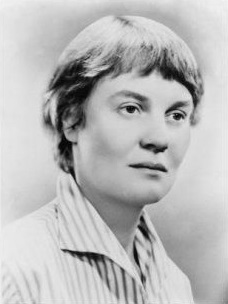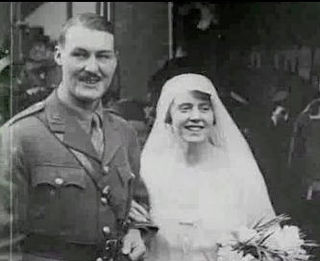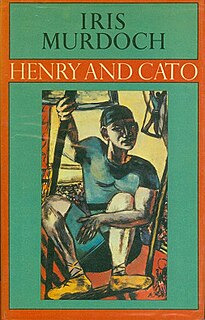
Dame Jean Iris Murdoch was an Irish and British novelist and philosopher. Murdoch is best known for her novels about good and evil, sexual relationships, morality, and the power of the unconscious. Her first published novel, Under the Net, was selected in 1998 as one of Modern Library's 100 best English-language novels of the 20th century. Her 1978 novel The Sea, the Sea won the Booker Prize. In 1987, she was made a Dame by Queen Elizabeth II for services to literature. In 2008, The Times ranked Murdoch twelfth on a list of "The 50 greatest British writers since 1945".
John Oliver Bayley, CBE, FBA, FRSL was a British academic, literary critic and writer. He was the Warton Professor of English at the University of Oxford from 1974 to 1992. His first marriage was to the novelist and philosopher Iris Murdoch.

A Severed Head is a satirical, sometimes farcical 1961 novel by Iris Murdoch. It was Murdoch's fifth published novel.

Sand art is the practice of modelling sand into an artistic form, such as a sand brushing, sand sculpture, sandpainting, or sand bottles. A sandcastle is a type of sand sculpture resembling a miniature building, often a castle.

The Red and the Green is a novel by Iris Murdoch. Published in 1965, it was her ninth novel. It is set in Dublin during the week leading up to the Easter Rising of 1916, and is her only historical novel. Its characters are members of a complexly inter-related Anglo-Irish family who differ in their religious affiliations and in their views on the relations between England and Ireland.

Sir John Campbell Longstaff was an Australian painter, war artist and a five-time winner of the Archibald Prize. He was a cousin of Will Longstaff, also a painter, as well as a war artist.

The Bell is a novel by Iris Murdoch. Published in 1958, it was her fourth novel. It is set in a lay religious community situated next to an enclosed order of Benedictine nuns in Gloucestershire.

Felicity, Lady Cory-Wright was an English baronetess and high society figure. A daughter of the actors Sir Herbert Beerbohm Tree and Helen Maud Holt, she appeared regularly in news of the time starting from infancy.

The Unicorn is a novel by Iris Murdoch. Published in 1963, it was her seventh novel.

The Love Eterne is a 1963 Hong Kong musical film of the Huangmei opera genre directed by Li Han Hsiang. An adaptation of the classic Chinese story "Butterfly Lovers", it tells of the doomed romance between the male Liang Shanbo and the cross-dressed female Zhu Yingtai.

The Sacred and Profane Love Machine is a novel by Iris Murdoch. Published in 1974, it was her sixteenth novel. It won the Whitbread Novel Award for 1974.

The Nice and the Good is a novel by Iris Murdoch. Published in 1968, it was her eleventh novel. The Nice and the Good was shortlisted for the 1969 Booker Prize.

An Unofficial Rose is a novel by Iris Murdoch. Published in 1962, it was her sixth novel.

Henry and Cato is a novel by Iris Murdoch. Published in 1976, it was her eighteenth novel.

An Accidental Man is a novel by Iris Murdoch, which was published in 1971. It was her fourteenth novel.

The Bottom of the Bottle is a novel by the Belgian writer Georges Simenon. The original French version Le Fond de la Bouteille, written in 1948 when Simenon was living in Arizona, appeared in 1949. The novel is among his romans durs, a term roughly translated as hard, or harrowing, novels; it was used by Simenon for what he regarded as his serious literary works.

The Time of the Angels is a philosophical novel by British novelist Iris Murdoch. First published in 1966, it was her tenth novel. The novel centres on Carel Fisher, an eccentric Anglican priest who is the rector of a London church which was destroyed by bombing during World War II. Fisher denies the existence of God and the possibility of human goodness in a post-theistic world. The novel, which has elements of Gothic fiction, received mixed reviews on its publication.

"Sandcastles in the Sand" is a song written by Craig Thomas and Carter Bays for the CBS television series How I Met Your Mother. The song was performed by Canadian actress Cobie Smulders in the role of Robin Scherbatsky, who has a secret past as a teenage Canadian pop star under the stage name Robin Sparkles. A follow-up to "Let's Go to the Mall" (2006), "Sandcastles in the Sand" was inspired by several 1980s pop ballads. The song was made available for streaming on April 15, 2008, before it appeared in an episode of the same name that aired on April 21. It was released as a single on April 23, and appeared on the soundtrack album How I Met Your Music (2012).

The Midnight Sky is a 2020 American science fiction film directed by George Clooney, based on the 2016 novel Good Morning, Midnight by Lily Brooks-Dalton. It stars Clooney, and follows a scientist who must venture through the Arctic Circle with a young girl to warn off a returning spaceship following a global catastrophe.
William Herbert Ingram was a Welsh writer and actor who had success in television and radio. He performed in his own plays for radio.


















